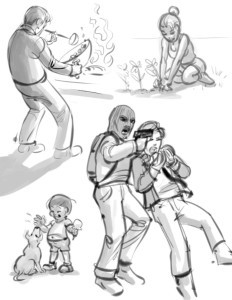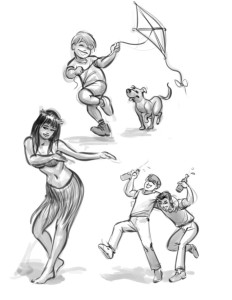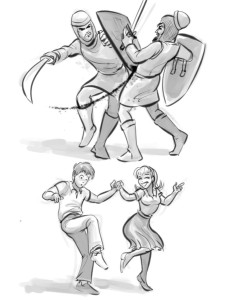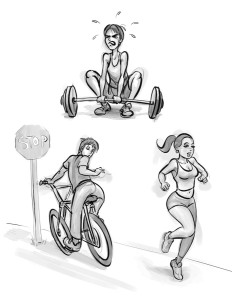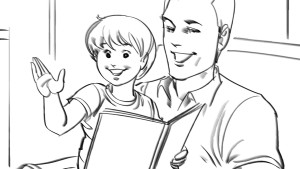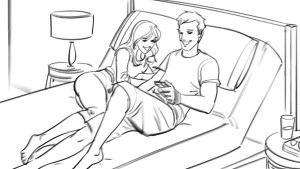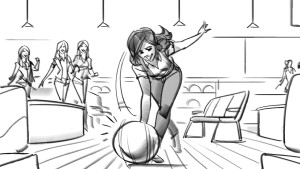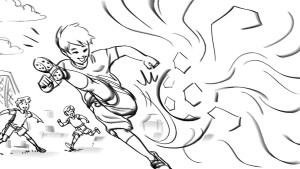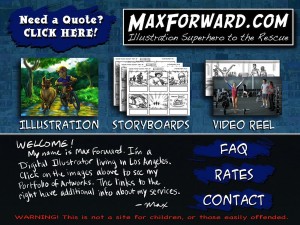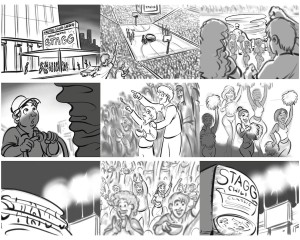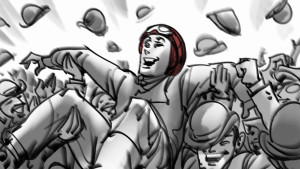The other day I received a very nice email from a reader of this blog, which expressed his interest in beginning work in the field of commercial storyboarding, and it briefly described the common frustrations one faces at the outset of one’s artistic career- “breaking in,” seemed, as he put it, a Catch-22 situation. How do you put together a storyboarding portfolio, when you have yet to actually work on any storyboarding projects? And so, after a lot of self-reflection, I crafted what turned out to be a bit of a lengthy response, and then decided that it contained enough good advice and interest to be merit an official blog post, so here we go!
Breaking in is a lot like a Catch-22. But as far as the early portfolio- it doesn’t either have to strictly be storyboards- how about a series of simple sample drawings, that show your ability to draw a range of subjects that feel applicable to multiple “types” of commercials? Like:
- A mother shopping in a market with her toddler in the shopping cart, and talking to a lady giving free samples of yogurt
- A coach giving inspiration to a team of professional athletes
- Best friends sharing a popsicle on a warm summer evening after losing a baseball game
- A woman ecstatic as she finds out she has won the lottery
- A woman who is annoyed that her boyfriend is ignoring her and checking his fantasy football scores on a date
- A grandpa amazed at his young grandson beating him at chess
Draw these scenes (or ones similar- i think you get the idea) from your imagination- and find the magical appeal that instantly communicates the context, and makes the viewer interested in seeing more of what they have just seen- as if the drawing has implied a greater story beyond the borders of the drawing. Something that resonates with the collective consciousness of humanity- that we can all relate to. One simple drawing to sum up each scene and instantly connects to the view succinctly and powerfully. If you can do that with QUICKLY with one image, the client will know you can do it with 10, or 20, or sometimes 30- and that’s a great storyboard: when each image can communicate not only the moment but the whole story as well.
I used this approach myself, when I was just starting out. It bypassed the Catch-22 paradox via substitution method- You don’t need actual storyboards to start out, just samples to show that you can ideate and draw quickly, simply, and communicate clearly. Keep them somewhat loose- show that you can get an idea across quickly and move on to the next one. It’s very important that you don’t get carried away because clients often need changes! Show some restraint. Below are the actual original sketches I included as drawing samples in my first online portfolio:
As you can see, they were not storyboards- but they were still story moments, and they showed a range of body types and ages, personalities, actions, humor, friendships, romance, sex appeal, and demonstrated a competent shorthand illustration style for well suited for sketching out story ideas. I look back on these drawings with a lot of emotions- mostly intense gratitude. I spent two hours on them and they essentially spawned my career. I don’t draw in this style anymore but their underlying appeal still exists in my drawings today:
These most recent random sampling of works above are pulled from much larger distinct storyboard sequences, but you can see that I never let go of the need to clearly communicate the appeal to our common everyday humanity in each frame. That’s a core skill in advertising.
If you are far on the outside and don’t have many leads for clients, I have a few suggestions, entirely based on my personal experience.
It turns out, many potential clients who are in need of storyboards are really quite desperate and will search for artists on Craigslist to do last-minute work or revisions for presentations. They may be “wannabes” themselves, but usually they still have some cash to spend. Or sometimes they are more established, but for whatever reason, their client’s clients made 11th hour creative changes and have demanded an unreasonable turnaround- and they need an artist in a hurry, but the original artist is out drinking or giving birth or something. So they go on Craigslist and look at artists who post “Artist for Hire” ads. Most of these artists aren’t that great, so if you can put up a link to a decent looking portfolio or sample artworks (please try to actually put together your own website and not rely on deviantart) you can have a good chance at them hitting you up. You don’t have to be the best, you just have to be the best available.
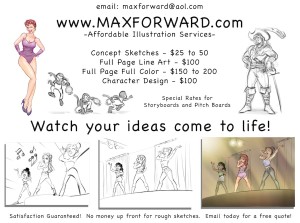
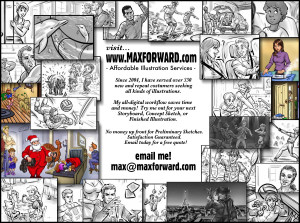
My first storyboarding gig (10 years ago) was for a Craigslist client (still a regular client to this day) and he was just starting out as a producer/director himself. He saw my ad, looked at my drawings, and was he desperate! It was 11pm and I couldn’t believe this random guy needed 9 frames before 6am. Utterly ridiculous! I was about to tell him off and he followed up with “and I can pay you $300”. Boy, that got my attention! All night I worked hard and did my best, and got the job done. It was a win-win; He made his presentation deadline, and I made a very decent payday for myself. He was very grateful and I felt like a superhero. I had done a dozen of gigs off craigslist at this point, but this was my first storyboarding gig- and it was hard, intense work, but it paid very well and most importantly: he came back again and again with more jobs- and each one was different and had new challenges!
The other day, my agent took me out to a very nice lunch and let me know I had become their most requested artist at the agency. That’s an amazing milestone for me to reflect on but I don’t want to let it go to my head- it’s a very fluid metric and I know there are many amazing artists out there who are eager to break in. 10 years in, 1000+ commercials later, the formula for success is still the same- One client, one project, one drawing at a time- do your best and slowly build your career. It’s the only way I know how.
Good Luck!
-Max

